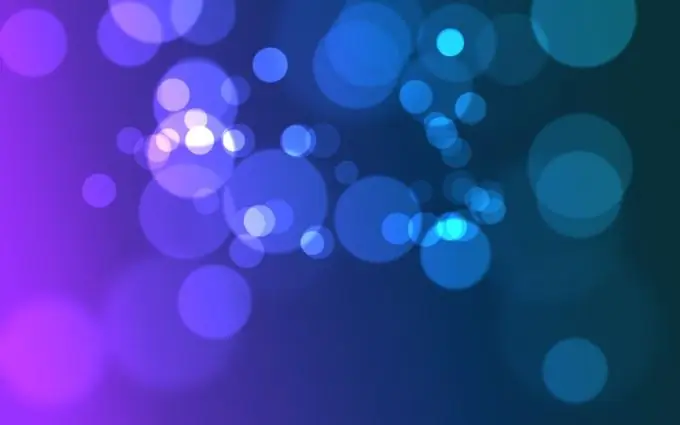Imitation of bokeh, the effect that occurs when a point in the out-of-focus area is displayed by a camera lens, has long been actively used in post-processing images. In other words, if you do not have a lens that would give beautiful bokeh in your photos, you should not despair. This painterly effect can be simulated using Photoshop.

Necessary
Photoshop program
Instructions
Step 1
Use the Ctrl + N keyboard shortcut to create a new document 16 centimeters wide and 10 centimeters high in RGB color mode. Fill the background with a gradient. To do this, select the Gradient Tool in the tool palette. Click on the colored bar under the main menu. In the window that opens, select any gradient you like from the palette or create a new one by clicking on the New button. Select the Linear style by clicking the appropriate button below the main menu. Click on the lower left corner of the document. While holding down the left mouse button, move the cursor to the upper right corner of the document and release the mouse button.
Step 2
Make a bokeh brush. To do this, create a new layer by clicking on the Create a new layer button. Select the Elliptical Marquee Tool ("Elliptical selection") and, holding down the Shift key, create a circular selection with this tool. Fill it with black using the Paint Bucket Tool. Right-click on the selection layer and select the Blending options menu item. In the window that opens, set the Fill opacity parameter to 50%. Check the Stroke checkbox and left-click on this item. Set the color to black in the Color field and click on the OK button.
Deselect the selection with the keyboard shortcut Ctrl + D. Turn off the visibility of the gradient layer by clicking on the eye icon to the left of the layer. Save the brush using the Define Brush Preset command from the Edit menu. In the dialog box that opens, enter a name for the brush and click on the OK button.
Turn off the visibility of the brush layer. Turn on the visibility of the gradient layer.
Step 3
Customize your brush. To do this, select the Brush Tool ("Brush") in the tool palette. Click on the arrow next to the Brush drop-down list and select the very last brush in the list. This is the brush you just saved. Open the Brush Preferences window with the Brushes command from the Window menu. Click on Brush Tip Shape. In the settings window, set the Diameter value to 68 pixels and the Spacing parameter to 115%. Click on Shape Dynamics and set the following parameter values: 90% for Size Jitter, 56% for Minimum Diameter and 5% for Angle Jitter. Check the Scattering checkbox, left-click on this item and set the Scatter parameter to 794%, unchecking the Both Axes checkbox. Set the Count parameter to 5, and set the Count Jitter parameter to 5%. Click on the Other Dynamics item and set the values of all parameters to 50%.
Step 4
Create multiple layers with bokeh effect. To do this, create a new group in the layers palette using the Create a new group button. From the drop-down menu in the upper left corner of the Layers palette, select the Blending Mode Color Dodge. In a new group, create a new layer by clicking on the Create a new layer button. Click on the arrow in the Brush Settings Panel and set the Master Diameter to 500 pixels. Choose white as the foreground color. Hold down the left mouse button and drag the cursor from the lower left corner to the upper right. Apply a Gaussian Blur filter from the Blur group of the Filter menu to the bokeh layer. In the parameter settings window, set the blur radius to 20 pixels, create a new layer and paint bokeh on it using a brush with a diameter of 300 pixels. Apply Gaussian Blur to this layer. Set the Blur Radius to 4 px, create another layer and paint bokeh on it with a 100 px brush. Apply a Gaussian Blur effect to the layer with a blur radius of 1 pixel and experiment with the layer blending mode to get the most interesting effect.
Step 5
Save the resulting image using the Save command from the File menu.






